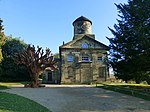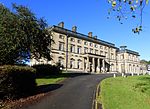Haigh railway station
1850 establishments in England1965 disestablishments in EnglandBeeching closures in EnglandDisused railway stations in WakefieldFormer Lancashire and Yorkshire Railway stations ... and 5 more
Pages with no open date in Infobox stationRailway stations in Great Britain closed in 1965Railway stations in Great Britain opened in 1850Use British English from August 2017Yorkshire and the Humber railway station stubs

Haigh railway station served the village of Haigh, West Yorkshire, England from 1850 to 1965 on the Hallam Line.
Excerpt from the Wikipedia article Haigh railway station (License: CC BY-SA 3.0, Authors, Images).Haigh railway station
Haigh Lane, Wakefield Woolley
Geographical coordinates (GPS) Address Nearby Places Show on map
Geographical coordinates (GPS)
| Latitude | Longitude |
|---|---|
| N 53.6053 ° | E -1.5481 ° |
Address
Haigh
Haigh Lane
S75 4BZ Wakefield, Woolley
England, United Kingdom
Open on Google Maps










